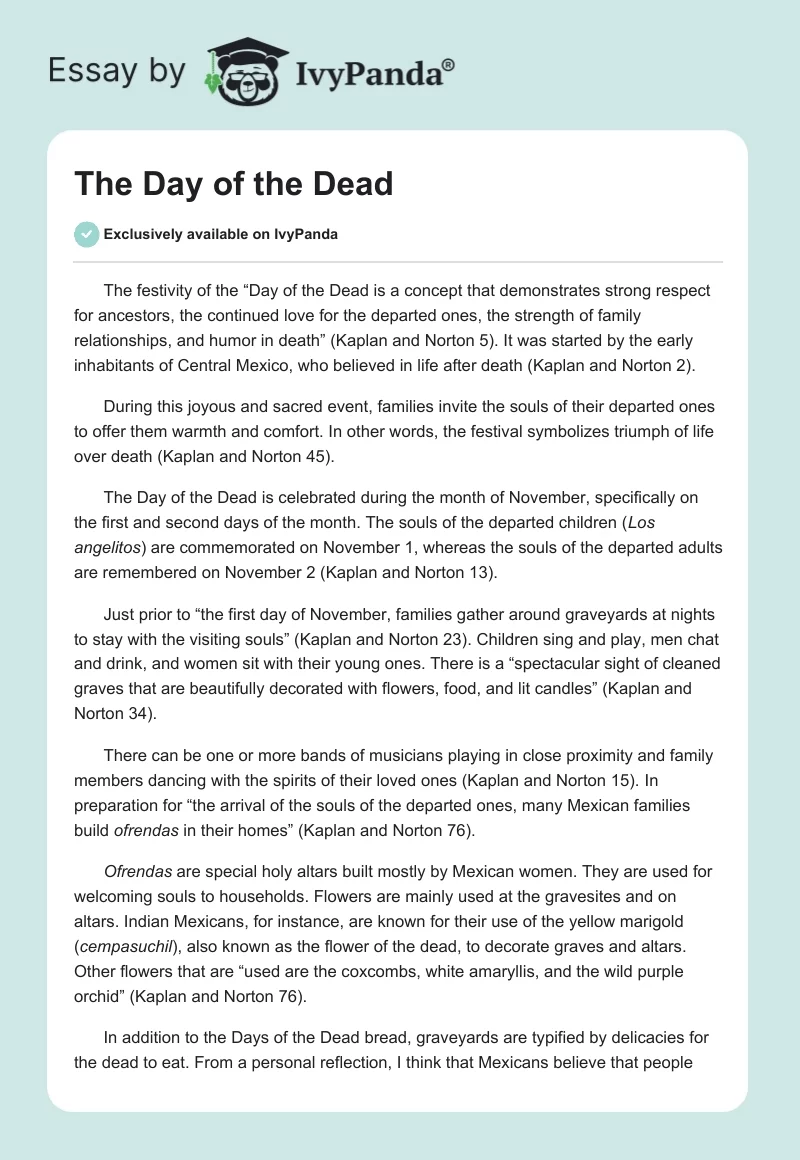The festivity of the “Day of the Dead is a concept that demonstrates strong respect for ancestors, the continued love for the departed ones, the strength of family relationships, and humor in death” (Kaplan and Norton 5). It was started by the early inhabitants of Central Mexico, who believed in life after death (Kaplan and Norton 2).
During this joyous and sacred event, families invite the souls of their departed ones to offer them warmth and comfort. In other words, the festival symbolizes triumph of life over death (Kaplan and Norton 45).
The Day of the Dead is celebrated during the month of November, specifically on the first and second days of the month. The souls of the departed children (Los angelitos) are commemorated on November 1, whereas the souls of the departed adults are remembered on November 2 (Kaplan and Norton 13).
Just prior to “the first day of November, families gather around graveyards at nights to stay with the visiting souls” (Kaplan and Norton 23). Children sing and play, men chat and drink, and women sit with their young ones. There is a “spectacular sight of cleaned graves that are beautifully decorated with flowers, food, and lit candles” (Kaplan and Norton 34).
There can be one or more bands of musicians playing in close proximity and family members dancing with the spirits of their loved ones (Kaplan and Norton 15). In preparation for “the arrival of the souls of the departed ones, many Mexican families build ofrendas in their homes” (Kaplan and Norton 76).
Ofrendas are special holy altars built mostly by Mexican women. They are used for welcoming souls to households. Flowers are mainly used at the gravesites and on altars. Indian Mexicans, for instance, are known for their use of the yellow marigold (cempasuchil), also known as the flower of the dead, to decorate graves and altars. Other flowers that are “used are the coxcombs, white amaryllis, and the wild purple orchid” (Kaplan and Norton 76).
In addition to the Days of the Dead bread, graveyards are typified by delicacies for the dead to eat. From a personal reflection, I think that Mexicans believe that people continue with life after they die. For instance, the departed ones are offered food at gravesides due to the fact that they still need to obtain good nutrition.
Towns in Mexico are characterized by very many people during the last days of October for the reason that almost every family member rushes to purchase materials needed for the decoration and preparation of altars. Special commodities are in adequate supply during this period to meet the relatively high demand.
They include clay candlesticks, plain or elegantly decorated candles, beautiful burners, skeleton figures, toys, and miniature dolls. Additionally, colorful paper cutouts are sold in shopping centers because they are special components in the preparation of altars. The significance of the paper cutouts is to appease and entertain the returning souls.
Most families prepare/bake special kinds of loaves of bread, called the bread of the dead, which are in unique shapes and sizes. The most amazing fact that surrounds the festivity and Mexican people is the lack of dull moods.
Personally, I think that people should be in a mourning mood when they are associating with the dead. In fact, it appears that the departed persons do not come to haunt or scare their loved ones, but they come from the ‘other world’ to visit their homes and look for comfort and care.
Works Cited
Kaplan, Robert, and David Norton. The fiesta of the day of the dead. Cambridge, MA: Harvard Business Press, 2011. Print.


